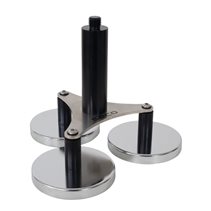Technology is improving at a phenomenal rate and it seems that every day, there is some new gadget or product, that has the possibility to make our life easier. Manufacturers in all sorts of industries are combining new technologies from different areas to offer better products than competition. Similar symbiosis can be found in (in my opinion) very interesting industries, that I’m addressing in this article. First thing that comes to mind when thinking about combination of auto industry and surveying is definitely satellite navigation, a commonly used surveying tool, that is frequently used for helping drivers reach their destination based on system’s maps and drivers position. But is there more to the link between surveying technology than just satellite navigation? In this article, I will present you two curious cases of that cooperation – 1) cars used as a platform for surveying purposes and 2) cars with autonomous driving capability, that use different variety of spatial sensors for enabling the driver to leave (almost) all controls to the machine.
Car as a surveying platform
Not only for driving us from office to a job-site, cars can be used in different areas, acting as a platform for implementing a variety of sensors for gathering spatial data. One of such cases is mobile mapping, which refers to the collection of geospatial data using mapping sensors mounted on moving platforms such as cars, marine vessels or airplanes. Mobile mapping systems utilize GNSS technology combined with Inertial Navigation Systems (INS) to enable the rapid and accurate calculation of continuous 3D position. Mobile mapping often happens using LIDAR mounted on a car roof. LIDAR is not a widely available technology, but provides extremely fast survey results for large-scale projects.It uses ultraviolet, visible, or near infrared light to image objects and can be used with a wide range of targets. A laser beam is used to map physical features with very high resolution (several hundred thousand points/sec).

But not only lidars can be mounted on top of a car. Also there are specific mounting pieces to connect your GNSS receiver on top of your car, which can be used for mapping a new road segment or similar.

As I mentioned before, a variety of sensors can be mounted on top of a car, and special case of this is Google earth’s camera, which captures images in 360°. Ever since the introduction in 2007 Google now has a fleet of cars, used for measuring surroundings used for e.g. Street View or Photo Sphere. Similar cameras are mounted also on other vehicles, such as tricycles, snowmobiles, robotic platform and even as a backpack unit.

Autonomous driving
Another area of collaboration between surveying and auto industry is automous vehicles. These vehicles, that drive themselves, are no longer a stuff of futuristic sci-fi movies. A large number of car manufacturers are developing technologies that will one day (maybe) take control of the car instead of the driver. 4 main goals, which they pursue in achieving that, are:
- Making vehicles which will automatically control the steering, the power delivery, and the breaking.
- Developing technology, that allows the vehicle to sense the environment around it.
- The processing – what does that vehicle determine, what decisions does it make based on the sensing of what is going on in its surroundings.
- The output – what actions does the vehicle make based on that processing.
Autonomous cars can detect surroundings using a variety of sensors, such as radar, LIDAR, different cameras, GPS systems in odometry, which uses the data from motion sensors to estimate change in position over time. Advanced control systems interpret gathered information to select appropriate navigation paths, determine obstacles and ‘read’ signs. Instruments incorporated in autonomous vehicles can be mounted in different areas of car – front bumper, behind windscreen, on the roof-top of the car. Manufacturers will in future try to incorporate those instruments in such way, that you won’t be able to notice, that a particular car is equiped with different sensors (unlike the blue Volkswagen Passat in the picture)

Infrared and optical sensors techonolgy can already be found in a number of car manufacturers such as Audi, Lexus, Subaru, Tesla and Mercedes. Lexus’ 2013 model LS 460, for example, features an Advanced Pre-Collision System (A-PCS). This system is connected with millimetre-wave radar, front facing near infrared projectors, and a front-mounted camera. All these sensors together help the car to avoid low-speed collisions by scanning vehicles in the near-to-far vicinity, determining potential collisions, and emitting audio visual indicators if a danger is present, and eventually operating automatically by braking.

Autonomous driving comes with quite a few positive side effect, once the majority of cars on the road become autonomous. There is a possible significant reduction of traffic related accidents, resulting in reduced number of deaths and injuries, and related costs, including lower insurance costs. There could be a major increase in roadway capacity, resulting in significantly less traffic congestion. Autonomous driving will also enhance mobility for the elderly, people with disabilities, and other groups of people, which would otherwise not be able to drive.
Since the fully autonomous cars are not quite there yet, in recent years another term has established itself: semi-autonomous driving, which incorporates different sensors and helps the driver, but the driver is still responsible for everything that happens. Volvo, Swedish car manufacturer, says that their car for example supports the driver with keeping the distance to the vehicle in front and keeping the car in the lane (accelerate, brake & steer) in speeds up to 130 km/h. However, the driver remains responsible for monitoring, supervision, and over all operation of the vehicle and is expected to actively participate in the driving.

Until the fully autonomous cars come into our everyday lifes, you can catch glimpse of the future – check out this video featuring the self-driving Mercedes S500. Pretty cool, if you ask me.
sources: https://www.google.com/streetview/understand/http://www.digitaltrends.com/cars/lidar-lasers-and-beefed-up-computers-the-intricate-anatomy-of-an-autonomous-vehicle/https://en.wikipedia.org/wiki/Autonomous_carhttp://www.volvocars.com/intl/about/our-innovation-brands/intellisafe/intellisafe-autopilot/this-is-autopilot/autonomous-drive-in-detailhttp://edition.cnn.com/2014/01/09/tech/innovation/self-driving-cars-ces/index.htmlhttp://www.surveying.com/Products/GPS-and-GNSS-Survey-Accessories/Magnetic-Mounts/5114-10

You must be logged in to post a comment.